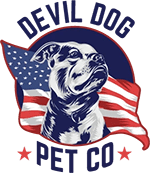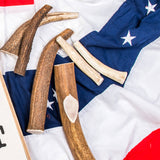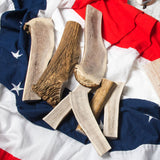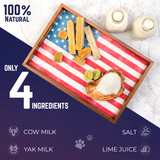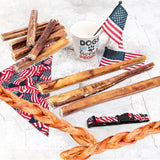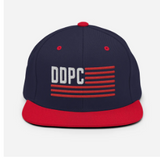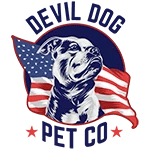From Our Dogs To Yours
Walk through any pet store or pet aisle and you will come across dozens of different chew toys and chew treats for your pup.
 A huge majority are plastic (or some other synthetic material) and almost all of them are factory made. While some are better than others, there are very few that are truly all natural. With more and more products coming from less regulated overseas manufacturers, it’s very important that you know what is going into your dog’s mouth and potentially their body.
A huge majority are plastic (or some other synthetic material) and almost all of them are factory made. While some are better than others, there are very few that are truly all natural. With more and more products coming from less regulated overseas manufacturers, it’s very important that you know what is going into your dog’s mouth and potentially their body.
We started using antler bones with our dogs over a decade ago. Having 2 large American Bulldogs at the time meant that anything and everything we were buying them to chew on was getting destroyed within a few hours. I needed something that was both safe and durable.
A friend with a large and very aggressive chewer told me about this new product his dog was loving and barely making a dent in. That conversation is what started our journey into the antler dog chew space.
Fast forward many years later, and we now sell thousands and thousands of antler chews each month to dog parents nationwide.
How are Antler Dog Chews Sourced? Where do they come from?
Each year in the spring, male Elk will literally drop their racks and regrow a new one. This process starts once the elk are around one year old and repeats itself on a yearly basis. Antlers start as layers of cartilage and do not get hard and mineralize until the end of the summer. During that growth phase, they are soft and covered with a skin of fur known as velvet.

During the summer, the antlers can grow at a rate of up to 1 – 1.5 inches per day. When the rack has matured, blood flow to the antler stops and that is when it begins to harden. At this point, the velvet starts to dry and the elk remove it by rubbing their racks on trees.
The marrow that is left in the antlers is very nutrient dense and an excellent source of essential minerals such as zinc, magnesium, glucosamine and calcium. When chewed, they are mess free and odor free.
Devil Dog Pet Co Antler Chews
Devil Dog Pet Co antler chews are 100% wild sourced and gathered by shed hunters throughout the Rocky Mountain region of the United States. We NEVER source our antlers from farms or ranches since there is a chance they can contain steroids, antibiotics and other, non-natural drugs. There is also a chance that the antler was not naturally shed and removed from the elk by being sawed off. We pride ourselves on being 100% cruelty-free.

Do Dogs Like Antlers?
Dogs love antlers. They have an instinctual desire to chew, which starts at a very young age when their teeth are developing. It’s your job as a dog parent to provide them with something suitable. Otherwise, this is when you start to see destructive behavior emerge. Young dogs need something they can focus on when those chewing urges arise, and we’ve personally found that antler dog chews are the perfect solution.

I’ve encountered too many scenarios where a dog has a huge basket of “toys”. Half of these are usually destroyed and falling apart, and the other half are normally not safe and horrible chew options. We need to understand that puppies are not toddlers and have ZERO need for plush dolls and squeaky rubber objects. You need to think ahead when you are laying the chewing foundation for your dog. What happens when you have a child, and they leave their stuffed animals and toys lying around?
Is your dog going to think they are his toys, also? Are they going to start chewing on them and destroying them? And worst-case scenario, are they going to get aggressive when the child tries to take one of their toys back from the dog?
We have a 3-year-old daughter who loves her dolls and stuffed animals. She also loves to leave them lying around; Including leaving them on the dog bed. Because antler chews are all our pups have ever known, we’ve never had a single incident of a baby toy being destroyed. They have zero desire to put anything other than an antler dog chew in their mouth.
Are Antler Dog Chews Safe? Are They Good for My Dog's Teeth?
This is probably the most controversial and most often brought up topic when discussing antler dog chews.
Speak with five different veterinarians, and you are likely to get five different answers. What we have found is that the number one reason vets are opposed to antler chews is because they state that antlers have the potential to damage teeth.
What’s important to understand is the tooth damage can happen with ANY hard chew. Or any hard object. I’ve spoken to more than one vet who’s had to treat a damaged tooth caused by chewing on rocks.
When properly educated on the topic of antler dog chews, most vets reverse their hard-line stance on antlers. Let me explain…
For started, vets typically clump all antlers under one category when there are actually three.
- Moose antlers
- Deer antlers
- Elk antlers
This is important because each kind has a different density to it and the potential for tooth damage is very different with each type.
Moose antlers are the hardest of the three and have very little “give” to them. They are typically thinner pieces with little to no soft marrow for the dog to go after. We have found these to be the least favorite for dogs when it comes to antler chews.
Next up is deer antlers. They are also what we consider a very hard antler with very little soft marrow for the dog to go after and consume.
Finally, we have elk antlers. Over the years, we’ve personally tried and sold all three types of antlers, and by a huge margin, elk is the doggie favorite.
Elk has that perfect balance of being a hard long-lasting chew along with having enough give that allows a pup to work through it and consume it over time. There is a hard outer casing that surrounds a center consisting of a softer, nutrient-dense marrow. That stuff drives dogs nuts and keeps them coming for more.
What dog parents (and vets) need to understand is that you GREATLY diminish (and practically) the odds of a tooth being damaged when you purchase the correct-sized antler for your pup. In the very rare and very few scenarios where I’ve had a direct conversation regarding a damaged tooth, 100% of the time, the cause has been an inappropriately sized antler.
Always get bigger than what you think your dog needs. Sizing charts are just a reference and if you are on the border of a size or you have a very aggressive chewer, I always recommend going at least one size (or more) bigger.
According to the charts, our pup should be getting a medium sized antler but we only giver her extra-large and jumbo pieces. She loves them and they last months and months.
When working on an antler, the dog should ALWAYS be grinding away at it and never biting down. This is why going big is important; Especially for pups that are new to antlers. When the piece is big enough, you essentially remove the ability for the dog to bite down on it even if they wanted to.
The grinding motion is what you want. It is what takes tartar and plaque of the teeth and keeps the teeth safe from damage.
Do Our Antler Chews Splinter?
This is the second most frequent question we get, and before I get into a detailed response, the short answer is no.
Splintering normally occurs when either quality is an issue or the wrong type of cut has been given to a dog.
Let’s talk about quality first. Antlers are graded on a scale that ranges from A to C/D.
We only deal with the top 5% of antler dog chews in the A range. These are fresh pieces, which have typically dropped within a few months of having been picked up. We have found these brown-ish pieces to be the most appealing to dogs.
One thing to keep in mind is that not all Grade A pieces will be brown. The color is determined by the region of the country where the elk lives and its environment. There are some areas that are not conducive to a dark brown color, and those antlers will be a much lighter color. This has no bearing on the quality.
Grade B antlers have typically been on the ground for at least 12 months and because of that, they’ve started to dry out and harden. It’s normal to see some cracks in grade B antlers. While, for the most part these are the same for dogs, they are not as appealing to them, and we do not deal in anything that is grade B or below.
Grade C/D is where you really start running into safety issues and are at the most risk for splintering. This is why you normally find it in big box pet stores. Two words for anyone looking at a grade C/D antler for their dog: STAY AWAY!
Now, let’s talk about antler cut. There are two types of cut you can order. A whole piece and a split piece.


A whole piece is just that; a section of the antler rack that has been cut. A split piece is when a whole piece is taken and then cut in half exposing the marrow.
While I am not a huge fan of split antlers, I am also not completely opposed to them. They have their place and a great chew in certain situations.
The huge majority of dog owners with healthy chewers will not need a split for most of their dogs life (if ever)
When you cut an antler in half, you are eliminating that protective casing that the dog must work through in order to get the prize; The marrow. With direct access to the marrow, a healthy chewer can quickly consume all that marrow and be done with the antler in just a few sittings. Fun for the dog but a waste of money for the dog owner. Plus, consuming too much marrow in one sitting can lead to indigestion and soft stools because the marrow is so nutrient dense.
Where I think splits are a good option is a young teething puppy who is just getting introduced to antlers for the first time or a senior dog with a soft chew and/or softer teeth. If you are ever unsure of which cut to get your dog, just ask.
Circling back to the splintering question; splintering can occur when a strong, healthy aggressive chewer is given a soft split and they are able to break pieces off since the protective casing is not there.
Are Devil Dog Antler Dog Chews Treated with Any Chemicals?
We will never treat our antler dog chews with any type of chemical or preservative. There is absolutely no need for it. On occasion, an antler may have some dirt on it and that will simply be washed off with some water. Antler chews are natures perfect treat and there is no need to ever do anything to them except give them to your dog to enjoy.
What size antler should I give my dog?
You know your dog best and more than anything, these are meant to be used as a general guideline. At the end of the day, it will come down to many factors including the size and breed, the dogs age, general health and chewing personality. As I mentioned earlier, when in doubt or if you are right in between two sizes, it is typically best to size up.

- Extra small / small chews: for dogs in the 5-25 pound weight range
- Medium chews: for dogs in the 20-45 pound weight range
- Large chews: for dogs in the 45-70 pound weight range
- Extra-large chews: for dogs in the 65-85 pound range
- Jumbo/Monster chews: for dogs that are 85+ pounds and for very aggressive and strong chewers
Do antler chews smell or cause a mess?
Short answer, no! While fresh antlers are very aromatic to dogs, the scent is undetectable to most people and if you do smell something, it is very faint and does not permeate a room like some other chews do.
Because they are not treated with any types of chemicals or dyes and because they are not dried out organ or body parts, antler dog chews do not make any kind of mess when being chewed. This is one of many reasons why they are such a favorite of dog owners everywhere; Especially those with carpets.
How long will my dogs antler chew last?
Rounding out the top 3 questions we get at number 3 is the “how long” question.
“If I buy my dog this chew, how long will it last them?”
That is probably the most difficult question to answer because so many different variables have to be taken into account.
In our household, we have some antlers that come and go within a month and a have some in our antler bin that are over a year old and still going strong.
Here are some of the many variable that need to be taken into consideration….
- What part of the rack is the antler from
- What size did you get them
- Is it a whole or a split
- Are they a soft chewer or aggressive chewer
- Are they a part time chewer or full time chewer
- Is it a single dog household or is it being shared by multiple dogs
- Do they just have one antler or several
Here are some tips to get the most life from your antler:
- Go big. If you dog is medium according to their weight, get them a large or extra large antler chew. Dogs love the challenge of a large chew and it will last them considerably longer
- Unless it’s a special situation where a split is really the only option for them, get them a whole antler
- If you have a multi dog household, at the very minimum, have at least one antler chew per dog
- Antler rotation makes them last considerably longer so if you just have one pup, get two antlers. You spend more money up front but you will have to replace them less frequently. In our antler bin, there is always at least 5-6 antlers and because of that, they all last about 3-4 times longer than they normally would. Dogs love to rotate.
At what age can I give my dog an antler dog chew?
On either end of the spectrum, we have found that there is no wrong age to give your pup an antler dog chew. We’ve given them to puppies as young as 8 weeks old and to senior dogs that are 14 years old.
What’s most is important is what life stage your dog is at and which antler dog chew is best suited for their current needs.
Our hope is that we’ve provided you with enough information in this piece that will allow you to make the best possible decision for your pup.
If you do have questions that were not answered, we are always just one email away.
